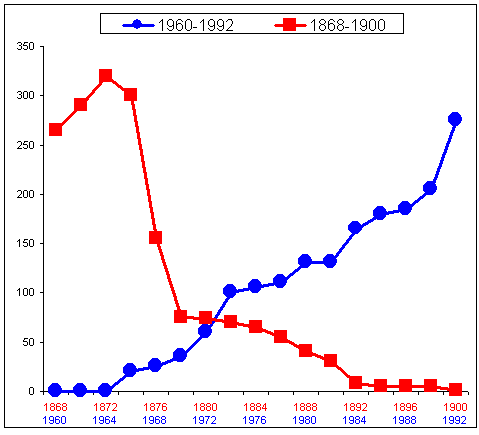

Soon after passage of the Voting Rights Act, federal examiners were conducting voter registration, and black voter registration began a sharp increase. The cumulative effect of the Supreme Court's decisions, Congress' enactment of voting rights legislation, and the ongoing efforts of concerned private citizens and the Department of Justice, has been to restore the right to vote guaranteed by the 14th and 15th Amendments. The Voting Rights Act itself has been called the single most effective piece of civil rights legislation ever passed by Congress.
The following table compares black voter registration rates with white voter registration rates in seven Southern States in 1965 and 1988:1/
| March 1965 | November 1988 | |||||
|---|---|---|---|---|---|---|
| Black | White | Gap | Black | White | Gap | |
| Alabama | 19.3 | 69.2 | 49.9 | 68.4 | 75.0 | 6.6 |
| Georgia | 27.4 | 62.6 | 35.2 | 56.8 | 63.9 | 7.1 |
| Louisiana | 31.6 | 80.5 | 48.9 | 77.1 | 75.1 | -2.0 |
| Mississippi | 6.7 | 69.9 | 63.2 | 74.2 | 80.5 | 6.3 |
| North Carolina | 46.8 | 96.8 | 50.0 | 58.2 | 65.6 | 7.4 |
| South Carolina | 37.3 | 75.7 | 38.4 | 56.7 | 61.8 | 5.1 |
| Virginia | 38.3 | 61.1 | 22.8 | 63.8 | 68.5 | 4.7 |
The following figure traces the number of black Southern legislators during two 32-year time periods -- from 1868 to 1900, and from 1960 to 1992:2/
Number of Black Southern Legislators, 1868-1900 and 1960-1992

A similar pattern is found when one examines elections for local offices as well. Although the legacies of racially polarized voting and discriminatory voting practices have not vanished, the Voting Rights Act has dramatically curtailed their effect.
1/ Adapted from Bernard Grofman, Lisa Handley and Richrad G. Niemi. 1992. Minority Representation and the Quest for Voting Equality. New York: Cambridge University Press, at 23-24.
2/ Adapted from J. Morgan Kousser. 1999. Colorblind Injustice: Minority Voting Rights and the Undoing of the Second Reconstruction. Chapel Hill: University of North Carolina Press, at 19.